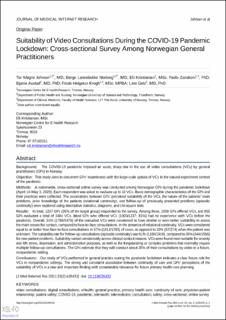| dc.contributor.author | Johnsen, Tor Magne | |
| dc.contributor.author | Norberg, Børge Lønnebakke | |
| dc.contributor.author | Kristiansen, Eli | |
| dc.contributor.author | Zanaboni, Paolo | |
| dc.contributor.author | Austad, Bjarne | |
| dc.contributor.author | Helgetun Krogh, Frode | |
| dc.contributor.author | Getz, Linn Okkenhaug | |
| dc.date.accessioned | 2021-08-11T06:14:02Z | |
| dc.date.available | 2021-08-11T06:14:02Z | |
| dc.date.created | 2021-02-09T08:54:17Z | |
| dc.date.issued | 2021 | |
| dc.identifier.issn | 1438-8871 | |
| dc.identifier.uri | https://hdl.handle.net/11250/2767255 | |
| dc.description.abstract | Background: The COVID-19 pandemic imposed an acute, sharp rise in the use of video consultations (VCs) by general practitioners (GPs) in Norway.
Objective: This study aims to document GPs’ experiences with the large-scale uptake of VCs in the natural experiment context of the pandemic.
Methods: A nationwide, cross-sectional online survey was conducted among Norwegian GPs during the pandemic lockdown (April 14-May 3, 2020). Each respondent was asked to evaluate up to 10 VCs. Basic demographic characteristics of the GPs and their practices were collected. The associations between GPs’ perceived suitability of the VCs, the nature of the patients’ main problems, prior knowledge of the patients (relational continuity), and follow-up of previously presented problems (episodic continuity) were explored using descriptive statistics, diagrams, and chi-square tests.
Results: In total, 1237 GPs (26% of the target group) responded to the survey. Among these, 1000 GPs offered VCs, and 855 GPs evaluated a total of 3484 VCs. Most GPs who offered VCs (1000/1237; 81%) had no experience with VCs before the pandemic. Overall, 51% (1766/3476) of the evaluated VCs were considered to have similar or even better suitability to assess the main reason for contact, compared to face-to-face consultations. In the presence of relational continuity, VCs were considered equal to or better than face-to-face consultations in 57% (1011/1785) of cases, as opposed to 32% (87/274) when the patient was unknown. The suitability rate for follow-up consultations (episodic continuity) was 61% (1165/1919), compared to 35% (544/1556) for new patient problems. Suitability varied considerably across clinical contact reasons. VCs were found most suitable for anxiety and life stress, depression, and administrative purposes, as well as for longstanding or complex problems that normally require multiple follow-up consultations. The GPs estimate that they will conduct about 20% of their consultations by video in a future, nonpandemic setting.
Conclusions: Our study of VCs performed in general practice during the pandemic lockdown indicates a clear future role for VCs in nonpandemic settings. The strong and consistent association between continuity of care and GPs’ perceptions of the suitability of VCs is a new and important finding with considerable relevance for future primary health care planning. | en_US |
| dc.language.iso | eng | en_US |
| dc.publisher | JMIR Publications | en_US |
| dc.rights | Navngivelse 4.0 Internasjonal | * |
| dc.rights.uri | http://creativecommons.org/licenses/by/4.0/deed.no | * |
| dc.title | Suitability of Video Consultations During the COVID-19 Pandemic Lockdown: Cross-sectional Survey Among Norwegian General Practitioners | en_US |
| dc.type | Journal article | en_US |
| dc.type | Peer reviewed | en_US |
| dc.description.version | publishedVersion | en_US |
| dc.source.volume | 23 | en_US |
| dc.source.journal | Journal of Medical Internet Research | en_US |
| dc.source.issue | 2 | en_US |
| dc.identifier.doi | 10.2196/26433 | |
| dc.identifier.cristin | 1887923 | |
| dc.description.localcode | ©Tor Magne Johnsen, Børge Lønnebakke Norberg, Eli Kristiansen, Paolo Zanaboni, Bjarne Austad, Frode Helgetun Krogh, Linn Getz. Originally published in the Journal of Medical Internet Research (http://www.jmir.org), 08.02.2021. | en_US |
| cristin.ispublished | true | |
| cristin.fulltext | original | |
| cristin.qualitycode | 2 | |

